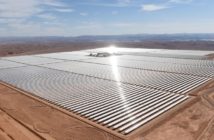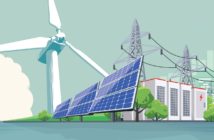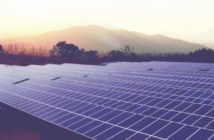EUROPOLITICS
By Marie-Martine Buckens
The creation of a vast electric ring, using renewable energies and connecting the countries of Europe, the Middle East and North Africa (EUMENA), is crucial for our energy future. That is how the CEO of the Desertec Industrial Initiative (Dii), Paul van Son, framed his report ‘Desertec power 2050’ when presenting it to Michael Koehler, the head of Energy Commissioner Günther Oettinger’s cabinet, on 21 June in Brussels.The report is timely. In its communication on the future of renewables, adopted on 6 June, the Commission points to the development of cross-border electricity exchanges as a key factor in ensuring the use of renewable energy, underlined Koehler. He added that the project could benefit from the European programme for supporting energy infrastructures.Above all, the Desertec project is a way for Europe to stock up on renewable electricity produced on the Southern banks of the Mediterranean – thus meeting up to 20% of its electricity needs. While the flow from South to North predominates, the report says, the project will be beneficial for all countries concerned. The study aims to prove this by analysing the entire EUMENA region for the first time, particularly by taking into account the growing demand for electricity from MENA countries, explained Mario Ragwitz, director of the renewables section at the Fraunhofer Institute for research on systems and ISI innovation – which contributed to the ‘Desert power 2050’ study. This demand, combined with population growth and the resulting need for jobs – could quadruple between now and 2050, therefore reaching 3,000 TWh. This subject should be addressed in more detail in a new report, expected in January 2013, which will include recommendations on measures to be taken at the regulatory level.
“WIN-WIN” INVESTMENTS
Koehler emphasised that the Commission’s communication highlights the need to produce renewables where it is most efficient, and this is not limited to the EU – but all of Europe. Desertec is a “win-win” project, he said. North African countries, including countries that produce hydrocarbons, such as Algeria, need renewables. The development of these countries will lead to increased internal consumption of gas, which creates a risk of overly reducing the volume of gas exports. The countries therefore need both renewables and partners.Moreover, said the head of Oettinger’s cabinet, the communication prioritises cross-border exchanges to boost renewables, and therefore priority is given to investment in infrastructures. The interconnection between Spain and Morocco, which allows the latter to stock up on less expensive electricity from Europe, was cited as an example. If in future the flow is reversed, this will create even more attractive investments, he said.
MEMBER STATE CONTRIBUTIONS
Van Son said that a step-by-step approach is needed in order to build a commercial model. Pilot projects have been launched in Ouarzazate in Morocco, for which sufficient guarantees have been obtained. Now, standardised plans, which are better adapted to the market, need to be adopted. Over the next 20 or 30 years, ad hoc market mechanisms should be developed, “but technologically we are not yet at this level,” he said, and therefore support is needed. Koehler reacted by pointing out that the EU does not just mean the Commission – member states also have a role to play. Certain countries, he added, for example small countries or those without much sunshine, could open up their subsidy systems to other countries in order to fill their quota of renewables. At the EU level, the main question is protecting investments via regional or bilateral legal frameworks. DG Energy should produce several communications on this in the coming months.
COLLABORATION WITH UFM
The Mediterranean Solar Plan (MSP), launched by the Union for the Mediterannean (UfM), is closely linked to Desertec, Koehler added. MSP projects are framework projects implying North-South or South-South coperation, or both, and these can be integrated perfectly with the Desertec project. For example, electricity produced by wind power in Egypt could supply Libya, which itself exports to Italy.The head of cabinet also brushed aside criticism made by some countries when they describe the Desertec project as “neocolonialism”. The Southern countries of the Mediterreanean frequently ask: ‘where are the jobs?’ It is clear that following the establishment of pilot projects, global solutions, which also include services, are needed. Van Son revealed that a few months ago Dii signed a cooperation agreement with the secretary-general of the Union for the Mediterranean. He added that the management of political and regulatory aspects is down to the Commission – Dii is there to deal with the technological aspect.
BackgroundLaunched at the same time as the MSP, in 2009, Dii is an industrial consortium, which brings together 56 companies, including the main German energy groups that helped create the initiative: E.ON, RWE and Deutsche Bank, and the reinsurer Munich Re, as well as the French company Saint-Gobain-Solar. The project foresees the creation of a large network of thermal and photovoltaic solar parks in the North African deserts, and also wind turbines across the Mediterranean, connecting continental Europe with the countries of the MENA zone using high-tension cables.
.






